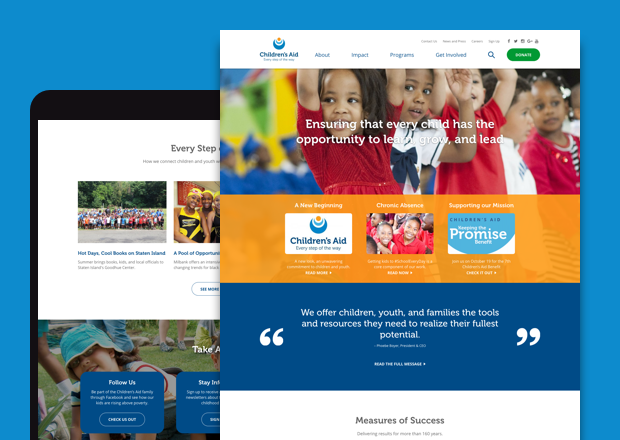 Support for Drupal 7 is ending on 5 January 2025—it’s time to migrate to Drupal 10! Learn about the many benefits of Drupal 10 and find migration tools in our resource center.
Support for Drupal 7 is ending on 5 January 2025—it’s time to migrate to Drupal 10! Learn about the many benefits of Drupal 10 and find migration tools in our resource center.Children’s Aid has been creating innovative solutions that help protect the wellbeing of children in New York City since the mid 1800s. Committed to ensuring there are no boundaries to young people’s aspirations, the organization provides a broad range of programs that tackle head-on the challenges faced by today’s youth.
The new childrensaidnyc.org better reflects the organization’s brand, effectively connects with key audiences and efficiently promotes programs from across New York City. The website powerfully tells the story of Children’s Aid and those it serves.

Children’s Aid already had experience with Drupal before this project, as the previous version of the website had been built in Drupal 6. As before, Drupal’s fieldable content model, powerful theme layer and huge ecosystem of contributed modules provided the flexibility Children’s Aid was looking for. Configuration management, views in core and TWIG-based templates were big draws for Drupal 8 specifically.
Children’s Aid wanted to better reflect its newly refreshed brand, to connect meaningfully with key audiences and to effectively represent itself as a leading innovator in its field. The redesign was executed in two phases: first, a user experience and design engagement; second, an implementation project to build the website in Drupal 8. The Drupal build needed to bring the design to life – on time and on budget.
Aten worked with Children's Aid in deeply collaborative development process that embedded the client’s developer directly into the project team. Together, we were able to maximize available resources to drive efficiencies both in budget and timeline. Equally valuable, the client’s technology team has full ownership and a deep working knowledge of the platform.
Technical specifications
Media entity provides flexible control of media content as entities, supporting a Create Once Publish Everywhere (COPE) content model and establishing the foundation for an easy-to-manage media library.
Search API (and Search API Solr specifically) provided powerful faceted search capabilities.
Geolocation views filters provided support for location-based content filters.
The paragraphs module was integral for establishing an adaptive content model that offers content writers and editors flexible control for building rich interactive stories, without sacrificing structure and maintainability.
The Paragraphs-based approach further solidified some of the work for the Stories module.
This project was executed by Children's Aid and Aten Design Group.